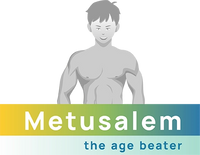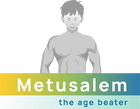Our Visions
We at Metusalem have set ourselves the goal of tracing, understanding, and analysing the complex relations of age and the associated illnesses in reports, experiments, and studies in modern science. We will then publish and report further on these insights in a comprehensible manner, and develop, produce, and market custom products within the scope of natural products and dietary supplements.
Our focus is to prevent the premature aging of the body’s cells with the help of strong antioxidants and free radicals, and to let the so-called “Hayflick” age of about 120 years to become the normal life expectancy. Furthermore, we aim to prevent the top 5 deadly chronic illnesses as far as possible, and to contribute to healing through mainstream medicine, and when possible finding a successful cure.
The “biological clock” of all living beings is also a central focus. In the nucleus of the cell, the respective genetic code in the form of a double helix, consisting of DNA and RNA, can be found. On their ends, a sheath-like structure can be found, which impedes damage and decay of genetic information, comparable to the plastic sheaths (aglets) on a shoelace. They are foundations of DNA and RNA; however, they don’t contain any genetic information and only protect the genetic information of the double helix from damage. The ends are termed telomeres and precisely these are of central importance to us at Metusalem BioLabs.
The telomeres shorten during the course of a lifetime, and in fact every time a cell divides itself. When our cells have divided and regenerated themselves from 60-80 times, the telomeres are too short and cell division and regeneration can no longer take place. This amounts to the death of the entire organism. This also happens in the course of very short, severe chronic illnesses. Many are not defined as chronic illnesses, but simply blamed on old age. However, the top 5 deadly illnesses such as cardio-vascular disease or cancer are directly correlated with the length of the telomeres. Much more research will certainly be necessary to clearly understand and impute the connections. However, what can be assumed and inferred from this is that long telomeres constitute a youthful biological age, and that short telomeres can be likened to old age.
First of all, the intervals of cell-divisions should be lengthened through healthy nutrition and lifestyle, and all cytotoxins such as oxygen radicals must be eliminated from the body. Simultaneously, it makes sense and is also simpler to repair the now longer living cells, and to lengthen the telomeres to the length they were before the previous cell division, or ideally beyond that. Meanwhile, science has detected and isolated many herbal substances that have the capability of activating an enzyme by the name of Telomerase. This enzyme is responsible for the regeneration and lengthening of telomeres, and occurs in normal adult cells only in the case of sperm cells and egg cells. Surprisingly, rogue cancer cells have been the first to discover the activation of telomerase. For this reason, they are, seen individually, “immortal.” It would be worthwhile to suppress the telomerase in cancer cells, and activate it in healthy ones. There are already promising lab results in the work of applying Resveratrol and Astragalus, among others, but much more research and time is required before medications and their derivatives are anticipated.
The bottom line is: We are attempting to slow the shortening and depletion of the telomeres while at the same time boosting the telomerase, with that, restoring the telomeres, in order to considerably lengthen the healthy lifespan.
Meanwhile, there is a major research group, mostly from California, that is also convinced of this, and works towards the same goals. David Sinclair is surely one of the most popular representatives of this aging research. Just seven years ago, his estimation to increase the lifespan was around 10-15 additional years of life, and the Hayflick age of around 120 years appeared possible to him. 2 years ago, however, he heightened his prognosis from his studies to 150 years of life. Nowadays he even believes 300 years of age will be possible. Other researches even envision 1000 years of life as achievable in a short time.
Besides nutrition, there are however other promising fields of science that to some extent exceed our power of imagination. First is the discovery of the Crispr Cas-9 genetic scissor. It is simple to operate, absolutely precise, and decidedly inexpensive. With it, it will be just as straightforwardly possible to edit genetic code, as you might write a text today. While evolution requires millions of years, with no possibility of predicting the outcome, today a previously determined outcome can be constructed in a few days. The hope remains that our species, the human race, will put the unimaginable benefits ahead of the just as significant risks, constructing a set of rules and laws that don’t originate from yesterday or the dark ages, and yet prevent any dire abuses as far as possible.
A further field is stem cell research. Young stem cells with long telomeres fulfil needs better than older stem cells with short telomeres.
The cultivation or creation of replacement organs through the body’s own cells and genetically modified animals is one of the many possibilities to influence future life expectancy.
In the meantime, every four years the knowledge of the medical field doubles, and these intervals of doubling will be even shorter in the future.
We live in a time in which most people will experience rapid changes in medical possibilities, and the possibilities that will exist, will radically lengthen the healthy life span. Large global corporations like Google, among others, have respectively put hundreds of millions into aging research and the race to the attainment of immortality seems to be open. We at Metusalem are taking part as early as possible so that as many people as possible can participate.
We will keep you updated on all the newest results of research in the topics and fields mentioned above under our menu heading “Blog.”

